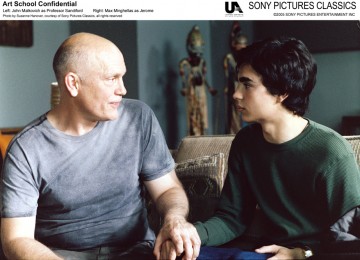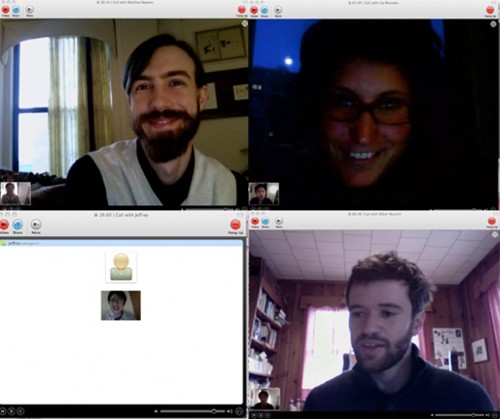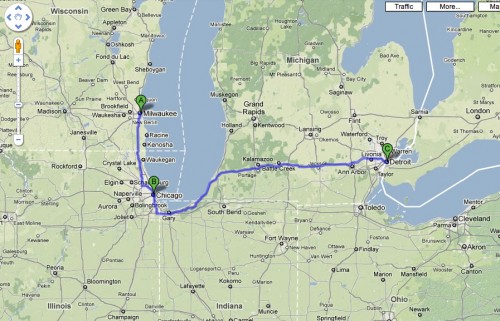
Still from "Art School Confidential." Left: John Malkovich as Professor Sandford, Right: Max Minghellas as Jerome. Photo by Suzanne Hanover, courtesy of Sony Pictures Classics, all rights reserved (c) Sony Pictures Entertainment Inc.
Art21’s Open Enrollment column is a forum for nine people currently enrolled in some form of art graduate study to take on a variety of topics and to challenge some of the existing conventions concerning the education of artists and art professionals. It will also serve as a document on the current state of advanced study in art.
Over the next several months, we eight will speak from our very different perspectives to cover a variety of topics: the crit, life after graduation, the educational canon, the role of history in art practice, the studio vs. the field, interdisciplinary study, competition, and many others.
So, to introduce you to ourselves and to the Open Enrollment column, Vency Yun and myself, Matthew Newton, have profiled our fellow bloggers and their schools to give you some perspective on who we are and how we are being educated.
First, Vency presents Lily Rossebo, Jeffrey Augustine Songco, Oliver Wunsch, and Daniel Ingroff while I profile Mike Brenner, Corina Reynolds, and Carrie McGath. Please enjoy this peek into our worlds, feel free to comment on this and future posts, and thank you for reading!
Vency Yun: It is 3pm in France and I’m sitting in my apartment with my afternoon café crème in hand, waiting for Lily, who lives in Edinburgh, Scotland, to Skype me. In many ways, this feels like the first day of school, where I’m about to meet four of my classmates: Lily (Edinburgh College of Art), Jeffrey (San Francisco Art Institute), Oliver (Williams College), and Daniel (The Mountain School of Arts) for the first time. Except our school is in cyberspace where they, like me, have registered for this Open Enrollment virtual classroom, to share and to write about our graduate school experiences. So this entry will be like a diary, where I note down what I so humbly learned from each person in contrast to the experiences that I’ve had at Concordia University in Montreal — because after all, I am a student who learns from her peers.
March 30th, 2010. The conversation with Lily took place just hours before her departure to Barcelona, as well as after she landed. She is a real traveler who just picks up and goes. My initial reaction was, how does she have such an open schedule? Does she not have classes or a studio to attend to? Ironically, she has neither, with the exception of a non-mandatory reading group that meets every three weeks where her tutorial leader and other students sit together and discuss Gaston Bachelard’s The Poetics of Space, Miwon Kwon’s One Place After Another, Werner Herzog’s Of Walking in Ice, and Foucault’s Heterotopias. Evidently, her program, Art, Space + Nature, is constructed quite differently than the Studio Arts program at Concordia, where I am required to take “X” amount of seminar classes on Situationism, Food and Art, and am given a studio for two years. What really delighted me was how her tutorial leaders (who are usually architects and painters) instigated learning symposia that extended beyond the four blank walls of the classroom, like the trip to two of the Orkney Islands, Hoy and Stromness. This was a trip that she and other first-year students took together with other graduate students from The Royal Danish Academy of Fine Arts, with the objective being “collaboration” — in particular, working on an exhibition at the Pier Art Centre that included time-based media, videos, installations, and performances.
March 31st, 2010. I am running through the orange-painted halls of the Université de Provence with my computer and Jeffrey so haphazardly attached to my Skype account, and I’m thinking to myself, “j’ai besoin d’une prise, immédiatement,” as I watch my computer take its last battery breath. Scheduling a conversation with Jeffrey was tricky as we had a 9-hour time difference between us. Nonetheless, it proved to be interesting and thought-provoking because when I spoke to Jeffrey, I was instantly drawn to how funny and laid-back he was. In many ways, I understand Jeffrey’s program a bit more, as it is closer to mine at Concordia, where within a large art school setting there are different art programs — like the New Genres program where Jeffrey has a private studio within a larger studio space that he shares with 12 others. That community is small and relationships are formed from day-to-day interaction — working on performances, setting up installations, meeting and collaborating with tutorial professors, and chatting about hegemony, post-colonialism, Marx, Veblen, and Foucault. There is an advocacy for the post-studio nomadic practice, and a stress for a “greener” way of life. Like many MFA programs, at the end of Jeffrey’s last year, he will participate in a final thesis exhibition on the pier, where each student will get an 8′ by 8′ cubical and the whole city is invited to celebrate. It is the thesis show that marks the difference between his school and mine; his show is a solidarity act and mine an independent one, as I am required to seek out my own gallery space in Montreal, or use the MFA Gallery to present my research/art/writing. Here, I am expected to defend my work in front of a five-panel thesis committee, who will either give me a pass or fail grade.
April 1st, 2010. My talk with Oliver was very challenging for me to understand, as he comes from a liberal arts and art historical background, while I hail from a fine arts one. And perhaps it is because of the vast difference between us that I learned the most about the way his school is structured. I sat there in front of my computer awed, as I was introduced to a slur of new writers who I didn’t even know existed, ranging from Alois Riegl to George Kubler. (Concordia’s studio practice is one that investigates contemporary art; hence we hardly look back at anything before the 20th century, except for the rare occasion.) Oliver is particularly interested in 18th-century painting and the competing influences between academic tradition and popular culture of the time. He introduced me to concepts from the French academy, such as the hierarchy of genres, where he explained that at the bottom of the chain are still life and animal images; moving upwards are landscapes and everyday scenes; slightly above are portraits; finally, at the top are history paintings based on allegories and myths. While he spends some time reading theoretical works (he groaned slightly about Derrida and Heidegger), his work is equally based on primary sources — texts he uses to help him read, interpret, and see paintings differently. But what really intrigued me about his program was hearing him describe how learning took place within small groups, internships, and travel. I enjoyed Oliver’s light-hearted story about his winter study trip, where his small department spent a month in Italy, starting in Sicily, then to Naples, Rome, and Florence, and a week in Venice. Led by professors, they looked at the Sistine Chapel and Piazza San Marco and studied art from a firsthand experience, rather than from a reproduction. He also has the opportunity to curate a show at MASS MoCA (Massachusetts Museum of Contemporary Art) in 2011, where he currently has an internship.
April 4th, 2010. Sometimes, my ego gets a bit inflated and I become overly confident about my knowledge on how to acquire higher education and how to learn, because I see myself as a lifelong student. Then I meet someone like Daniel, who so sincerely destabilizes my views and throws me a curve ball, and I think to myself, ‘wow – I’m learning something outside of the box!’
Daniel spent 3 months at the Mountain School in Los Angeles, a possible alternative or supplement to the MFA. The school is a project started by Piero Golia and Eric Wesley, which provide free education to its students. Pretty much anybody can apply to the school, with the only admission requirement being that each candidate writes an essay that addresses the question, “Tell Us About Yourself,” a deadly combination of words that can easily provoke an existential crisis. Once admitted, class sizes are small, usually made up of 14 people from diverse backgrounds who are carefully selected, ranging from writers and artists to just about anybody who is eager to learn. Here, students meet at 6pm sharp, twice a week, at the Mountain Bar located in downtown Chinatown. Classes are casual and laid back, where students discuss among themselves ideas about Kant, Heidegger, and Plato. What really fascinated me about Daniel’s program is the breakdown of his 10 hours/week — how classes are not limited to a seated intellectual exchange of ideas or a display of art theory slides, but rather students visit high profile working artists and their studios (artists that I only know through catalogues and magazines). Some of the studios that Daniel visited were those of Andrea Zittel, Paul McCarthy, Fritz Haeg, and Richard Jackson. They also attended artist talks by Dan Graham, Vanessa Beecroft, Simone Forti, and Thomas Demand. From here onwards, Daniel also introduced me to the Public School, another alternative project that offers free education to its students, where anybody can attend, propose, and teach classes. The idea is to generate dialogue, to bring communities together in a mode that is atypical and unconventional compared to the university model. Here you can take a class on “Gender and Science Fiction” if you so wish.
Matthew Newton: I didn’t realize it until my third conversation, but it stood out to me that all of the Open Enrollment bloggers I am presenting to you are currently studying and working in the Midwestern United States. In fact, with a quick six-hour car ride, you could visit all three of them. It may be that I have developed tunnel vision in my year and a half in New York City, but I was surprised to see such a large contingent from the Heartland —there’s art in Detroit?! (condescending, I know…). Perhaps this is an arbitrary grouping, but I quickly found the stories and personalities of Mike, Corina, and Carrie to be very much invested in their respective places and these, in turn, reflect their practices — just as much as I’m influenced by my own new hometown. So, by introducing these three from middle America, I hope give you an idea of where they are coming from, the types of issues that are important to them and, in the process, present a little of myself as well.
First, I would venture to say that Mike Brenner is the wild card of all nine of us. When one sets out into the artist life, most of us don’t imagine that path leading to an executive MBA program. Rubbing shoulders with corporate business leaders and reading texts on how to manage employee discipline doesn’t exactly fit the artist life stereotype (unless you’re Jeffrey Deitch, in which case an MBA-mind may just be your ticket to the director’s chair). And while Mike doesn’t call himself an artist, he did choose the MBA deliberately, strategically, to nurture the arts community of Milwaukee from the inside-out. Mike took the basic narrative of a gallery show (put a bunch of art on the walls and serve free booze to get the crowds in the door) and turned it upside-down: use the structure of a business to start a brewery, generate lots of alcohol and lots of space; then the artists will gravitate to it and do something special. I would say that Mike exemplifies a true DIY entrepreneurial spirit. While people like me give up on their hometowns and move to the big city to plug into the system, Mike’s goal is to meaningfully raise the profile and viability of the art community right where he is in Milwaukee, helping to facilitate artists’ ability to make a life for themselves there.
Across the lake and the lower peninsula, on the outskirts of Detroit, Corina Reynolds, like myself, does call herself an artist and is enrolled in a ticketed studio art MFA program at the Cranbrook Academy of Art. She moved from sunny San Diego to Motown to join the Fibers Department in a purposeful departure from her printmaking roots. And similar to Mike, I found that the theme of community meant much to Corina. Cranbrook’s education model relies on importing artists and information to the relatively isolated campus (students often refer to it as “the island”). There are even no official teachers or classes. This dynamic makes an artist like Corina, who is “always searching for a broader critical perspective,” particularly helpful to her community. In her program, the student population becomes an integral part of the experience because one ends up seeing a lot of them, even to the point of serving each other drinks at the student-run and populated bar. The benefit to this reclusion is that one’s studio practice becomes paramount and intensive. Interestingly, from what I’ve seen of it so far, Corina’s work seems to be reaching out of this hermetic place, specifically eliciting human connectivity.
Shortly after finishing my conversation with Corina, Carrie McGath and I sat down for our interview. She, in Chicago, was listening to Neil Young with a beer; I was playing Neil-influenced Brooklynite Sharon Van Etten with a glass of merlot. A good start for most any conversation! If Mike is the business leader and Corina the studio artist, Carrie is the art critic. Carrie’s program, New Arts Journalism at the School of the Art Institute of Chicago, is a brand-new experimental take on educating arts writers. While speaking with Carrie, I found her passion for reading and her passion for supporting the Chicago art scene in equal measure. Mentioning that I have a young daughter, Carrie immediately replied with the suggestion to find Dare Wright books to read her. When I said I lived and worked in NYC, she gave a lively (nearly fiery) advocacy of Chicago’s grassroots, do-it-because-you-love-it art scene. We also bantered about Acconci, Ashberry, and the intersection of words and visual art and how each can manifest the other — a topic of particular interest to her. My lasting impression of Carrie was of a person firmly, matronly, committed to an expansive set of interests that grow from a localized worldview.
For myself at Hunter College in Manhattan, surrounded by the intensity and largeness of the New York art world, I can’t overstate the influence that this city has had on my work, my education, and the way I see myself as an artist — for better or worse. But I also feel very simpatico with these three. Having come recently from Georgia’s more regionalized art world myself, their stories remind me of my own and I admire that they are actively generating dialogue in their communities. And despite their current proximity in the Midwest, it would be difficult to find three more different takes on graduate art education.
Vency Yun is a neurotic, artist, foodie, and writer who grew up in both Toronto and Hong Kong. She is completing her M.F.A in Sculpture at Concordia University, Montreal. Her work often involves food allergies, narration, and language. Currently she is in Marseille, France, working on the bouillabaisse project, which is an existential philosophical inquiry into fish soup!Matthew Newton is an artist and attends Hunter College’s Studio Art MFA program in Manhattan. His work includes painting, photography, writing, video, sculpture, and installation. He lives in New York City with his wife and daughter.






Pingback: New Blogger at Art21 Blog « Venice Biennale 2023
Pingback: Life After Graduation | Art21 Blog